Abstract
Prairie voles (Microtus ochrogaster) are monogamous rodents that form pair bonds characterized by a preference for a familiar social partner. In male prairie voles, exposure to either the stress of swimming or exogenous injections of corticosterone facilitate the development of a social preference for a female with which the male was paired after injection or swimming. Conversely, adrenalectomy inhibits partner preference formation in males and the behavioral effects of adrenalectomy are reversed by corticosterone replacement. In female prairie voles, swim stress interferes with the development of social preferences and corticosterone treatments inhibit the formation of partner preferences, while adrenalectomized females form preferences more quickly than adrenally intact controls. Because sex differences in both behavior and physiology are typically reduced in monogamous species, we initially predicted that male and female prairie voles would exhibit similar behavioral responses to corticosterone. However, our findings suggest an unanticipated sexual dimorphism in the physiological processes modulating social preferences. This dimorphic involvement of stress hormones in pair bonding provides a proximate mechanism for regulating social organization, while permitting males and females to adapt their reproductive strategies in response to environmental challenges.
Full text
PDF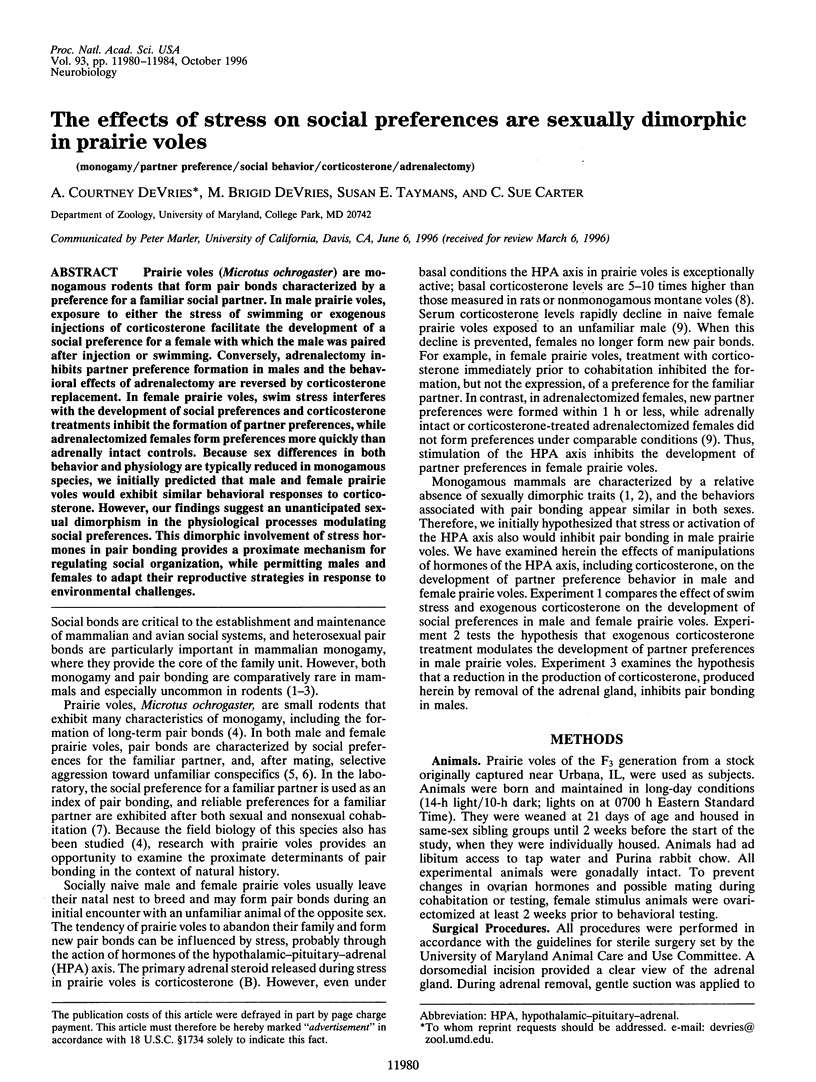
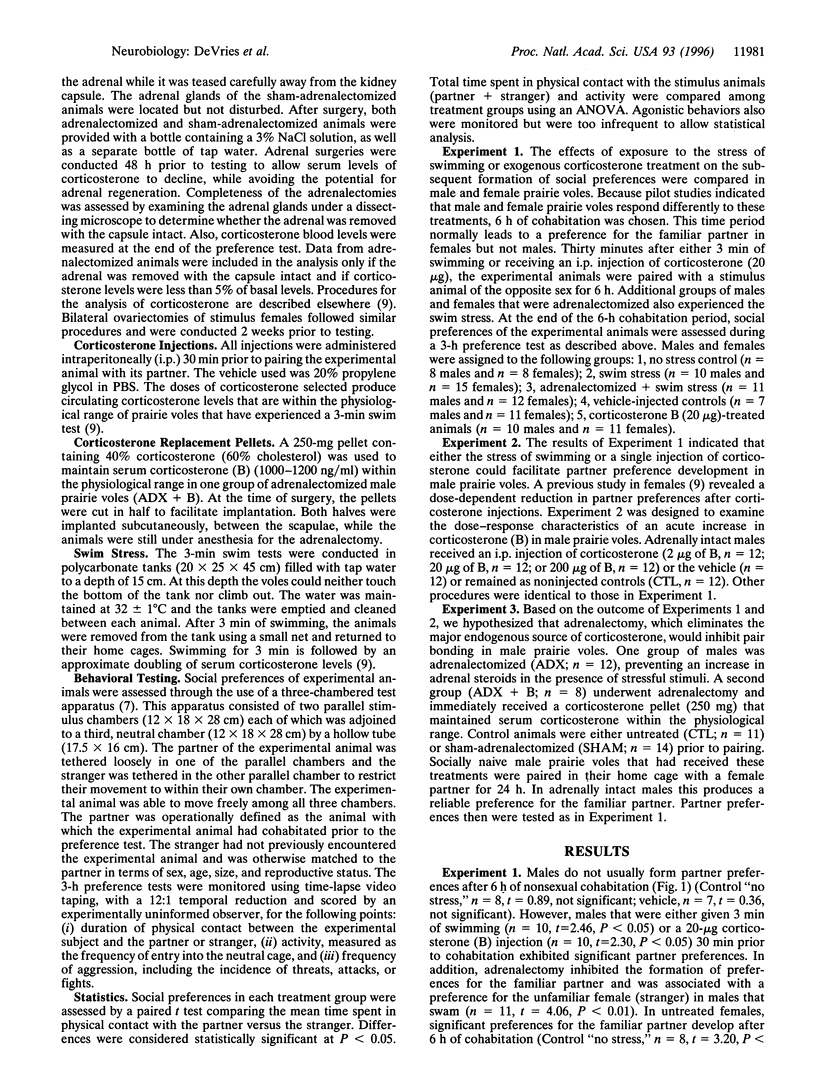
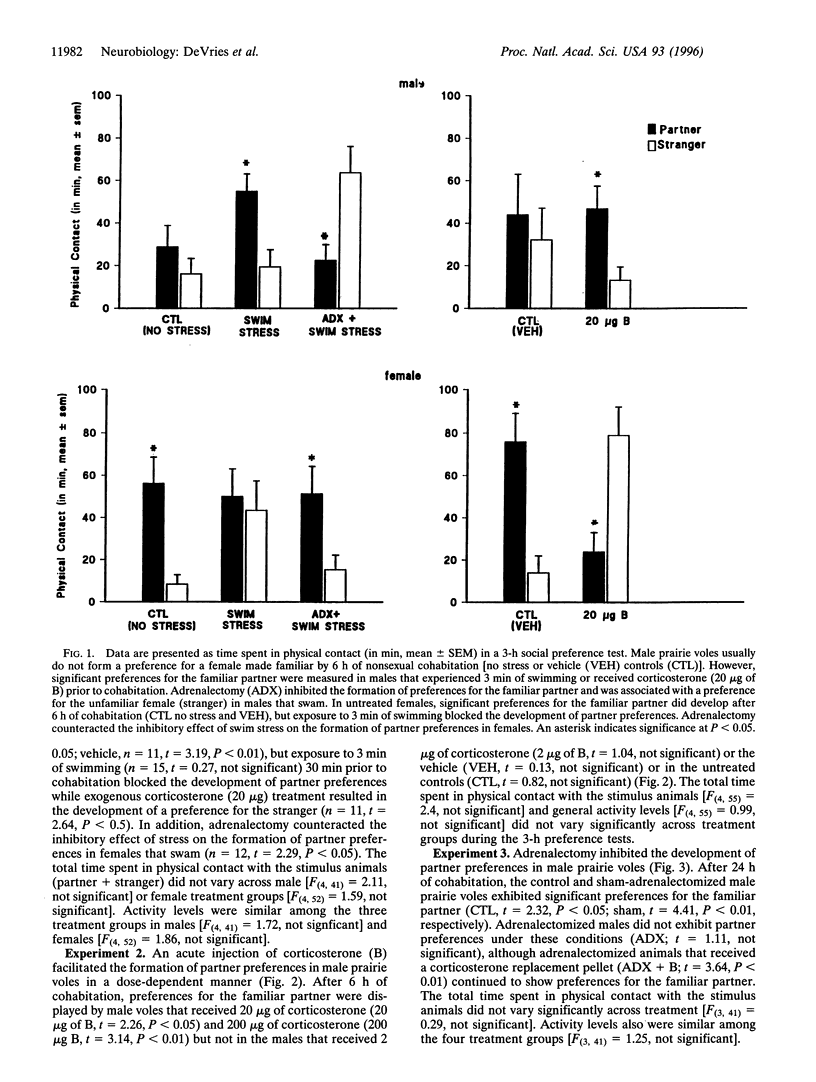
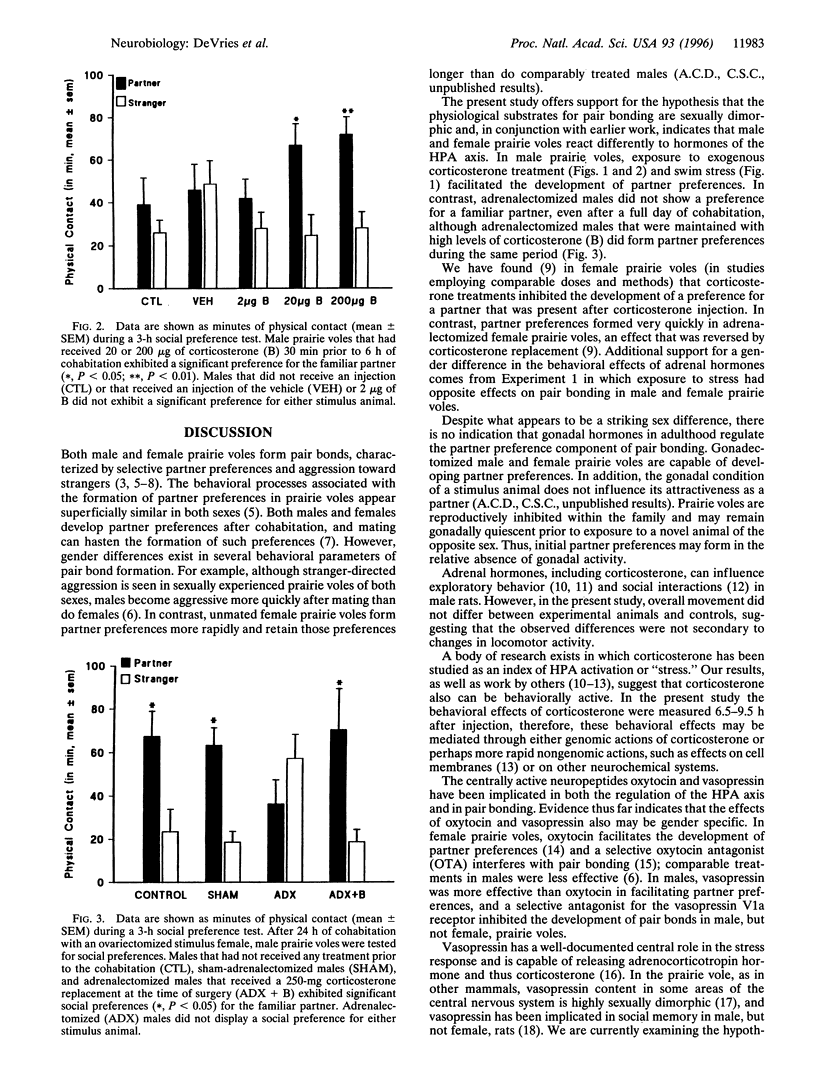
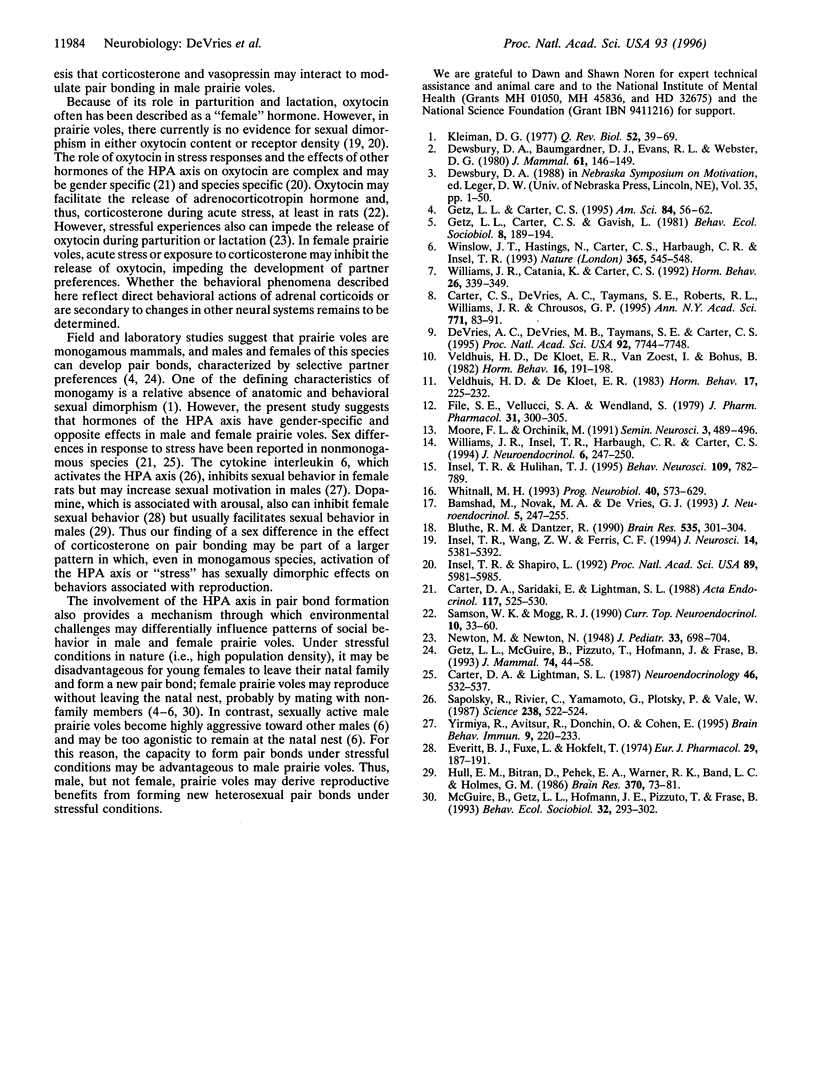
Selected References
These references are in PubMed. This may not be the complete list of references from this article.
- Bamshad M., Novak M. A., De Vries G. J. Sex and species differences in the vasopressin innervation of sexually naive and parental prairie voles, Microtus ochrogaster and meadow voles, Microtus pennsylvanicus. J Neuroendocrinol. 1993 Jun;5(3):247–255. doi: 10.1111/j.1365-2826.1993.tb00480.x. [DOI] [PubMed] [Google Scholar]
- Bluthé R. M., Dantzer R. Social recognition does not involve vasopressinergic neurotransmission in female rats. Brain Res. 1990 Dec 10;535(2):301–304. doi: 10.1016/0006-8993(90)91613-l. [DOI] [PubMed] [Google Scholar]
- Carter C. S., DeVries A. C., Taymans S. E., Roberts R. L., Williams J. R., Chrousos G. P. Adrenocorticoid hormones and the development and expression of mammalian monogamy. Ann N Y Acad Sci. 1995 Dec 29;771:82–91. doi: 10.1111/j.1749-6632.1995.tb44672.x. [DOI] [PubMed] [Google Scholar]
- Carter D. A., Lightman S. L. Oxytocin responses to stress in lactating and hyperprolactinaemic rats. Neuroendocrinology. 1987 Dec;46(6):532–537. doi: 10.1159/000124876. [DOI] [PubMed] [Google Scholar]
- Carter D. A., Saridaki E., Lightman S. L. Sexual differentiation of oxytocin stress responsiveness: effect of neonatal androgenization, castration and a luteinizing hormone-releasing hormone antagonist. Acta Endocrinol (Copenh) 1988 Apr;117(4):525–530. doi: 10.1530/acta.0.1170525. [DOI] [PubMed] [Google Scholar]
- DeVries A. C., DeVries M. B., Taymans S., Carter C. S. Modulation of pair bonding in female prairie voles (Microtus ochrogaster) by corticosterone. Proc Natl Acad Sci U S A. 1995 Aug 15;92(17):7744–7748. doi: 10.1073/pnas.92.17.7744. [DOI] [PMC free article] [PubMed] [Google Scholar]
- Dewsbury D. A., Baumgerdner D. J., Evans R. L., Webster D. G. Sexual dimorphism for body mass in 13 taxa of muroid rodents under laboratory conditions. J Mammal. 1980 Feb;61(1):146–149. [PubMed] [Google Scholar]
- Everitt B. J., Fuxe K., Hökfelt T. Inhibitory role of dopamine and 5-hydroxytryptamine in the sexual behaviour of female rats. Eur J Pharmacol. 1974 Nov;29(1):187–191. doi: 10.1016/0014-2999(74)90190-3. [DOI] [PubMed] [Google Scholar]
- File S. E., Vellucci S. V., Wendlandt S. Corticosterone -- an anxiogenic or an anxiolytic agent? J Pharm Pharmacol. 1979 May;31(5):300–305. doi: 10.1111/j.2042-7158.1979.tb13505.x. [DOI] [PubMed] [Google Scholar]
- Hull E. M., Bitran D., Pehek E. A., Warner R. K., Band L. C., Holmes G. M. Dopaminergic control of male sex behavior in rats: effects of an intracerebrally-infused agonist. Brain Res. 1986 Apr 2;370(1):73–81. doi: 10.1016/0006-8993(86)91106-6. [DOI] [PubMed] [Google Scholar]
- Insel T. R., Hulihan T. J. A gender-specific mechanism for pair bonding: oxytocin and partner preference formation in monogamous voles. Behav Neurosci. 1995 Aug;109(4):782–789. doi: 10.1037//0735-7044.109.4.782. [DOI] [PubMed] [Google Scholar]
- Insel T. R., Shapiro L. E. Oxytocin receptor distribution reflects social organization in monogamous and polygamous voles. Proc Natl Acad Sci U S A. 1992 Jul 1;89(13):5981–5985. doi: 10.1073/pnas.89.13.5981. [DOI] [PMC free article] [PubMed] [Google Scholar]
- Insel T. R., Wang Z. X., Ferris C. F. Patterns of brain vasopressin receptor distribution associated with social organization in microtine rodents. J Neurosci. 1994 Sep;14(9):5381–5392. doi: 10.1523/JNEUROSCI.14-09-05381.1994. [DOI] [PMC free article] [PubMed] [Google Scholar]
- Kleiman D. G. Monogamy in mammals. Q Rev Biol. 1977 Mar;52(1):39–69. doi: 10.1086/409721. [DOI] [PubMed] [Google Scholar]
- Sapolsky R., Rivier C., Yamamoto G., Plotsky P., Vale W. Interleukin-1 stimulates the secretion of hypothalamic corticotropin-releasing factor. Science. 1987 Oct 23;238(4826):522–524. doi: 10.1126/science.2821621. [DOI] [PubMed] [Google Scholar]
- Veldhuis H. D., De Kloet E. R. Antagonistic effects of aldosterone on corticosterone-mediated changes in exploratory behavior of adrenalectomized rats. Horm Behav. 1983 Jun;17(2):225–232. doi: 10.1016/0018-506x(83)90009-0. [DOI] [PubMed] [Google Scholar]
- Veldhuis H. D., De Kloet E. R., Van Zoest I., Bohus B. Adrenalectomy reduces exploratory activity in the rat: a specific role of corticosterone. Horm Behav. 1982 Jun;16(2):191–198. doi: 10.1016/0018-506x(82)90018-6. [DOI] [PubMed] [Google Scholar]
- Whitnall M. H. Regulation of the hypothalamic corticotropin-releasing hormone neurosecretory system. Prog Neurobiol. 1993 May;40(5):573–629. doi: 10.1016/0301-0082(93)90035-q. [DOI] [PubMed] [Google Scholar]
- Williams J. R., Catania K. C., Carter C. S. Development of partner preferences in female prairie voles (Microtus ochrogaster): the role of social and sexual experience. Horm Behav. 1992 Sep;26(3):339–349. doi: 10.1016/0018-506x(92)90004-f. [DOI] [PubMed] [Google Scholar]
- Williams J. R., Insel T. R., Harbaugh C. R., Carter C. S. Oxytocin administered centrally facilitates formation of a partner preference in female prairie voles (Microtus ochrogaster). J Neuroendocrinol. 1994 Jun;6(3):247–250. doi: 10.1111/j.1365-2826.1994.tb00579.x. [DOI] [PubMed] [Google Scholar]
- Winslow J. T., Hastings N., Carter C. S., Harbaugh C. R., Insel T. R. A role for central vasopressin in pair bonding in monogamous prairie voles. Nature. 1993 Oct 7;365(6446):545–548. doi: 10.1038/365545a0. [DOI] [PubMed] [Google Scholar]
- Yirmiya R., Avitsur R., Donchin O., Cohen E. Interleukin-1 inhibits sexual behavior in female but not in male rats. Brain Behav Immun. 1995 Sep;9(3):220–233. doi: 10.1006/brbi.1995.1021. [DOI] [PubMed] [Google Scholar]


